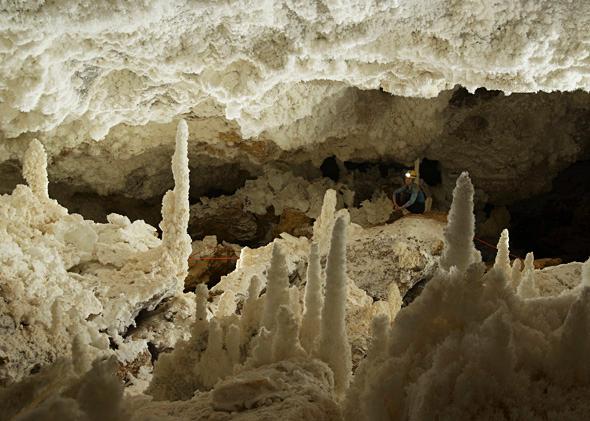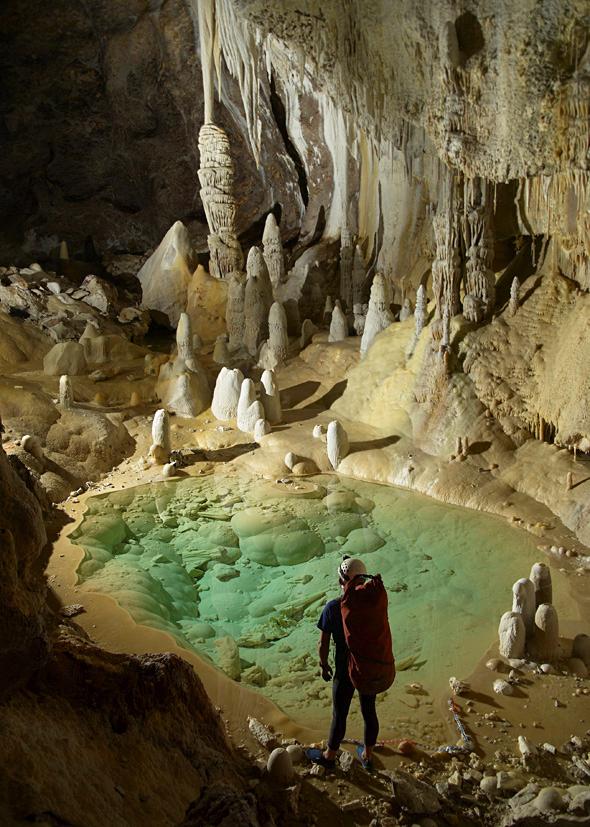Inaccessible to normal modes of transport and the global view of human technology, there are few places on Earth of which we remain oblivious—perhaps the deep ocean, or the remote, ice-capped mountains of Central Asia? In most cases, access to these areas is a tremendous logistical challenge, requiring the support of governments or a generous donor. But there is one realm in exploration that remains open to the weekend warrior, that needs little more than a helmet, a light, and a willingness to endure a little risk: caves. And as I have learned, the rewards of cave exploration go far beyond the personal adrenaline rush. The depths of the Earth are rich in amazing materials that may help us solve one of the most pressing concerns in medicine today.
Carved by chemistry and the action of water on rock, caves form over geologic time scales of millennia to eons. Underground, hidden from the vision of satellites and inaccessible to GPS signals, the only way to find a cave and map it, is to explore it. And explore caves, we do. While modern technologies cannot let us see inside caves, they can help us detect that enormous sinkhole in the middle of China, or a massive river suddenly disappearing into a Laos mountain, or telltale geologic scars across the surface of a tepui mountain in Venezuela. We are in the middle of a golden age of cave exploration, as expeditions uncover the largest, longest, and deepest caves on Earth hidden, for the most part, from the public eye.
The recently discovered Son Doong Cave in Vietnam has a passageway that barrels straight into a mountainside for a whopping five miles, with dimensions that could comfortably fit a 747 in flight. Sarawak Chamber in Gua Nasib Bagus Cave, Borneo, could accommodate the Superdome, its 72,000 visitors, and if parked New York garage-style, most of their cars. I myself was involved in the discovery of the massive Cloud Ladder Hall in China; the 16-acre room named because its enormous, 1,200-foot-high ceiling is large enough to accommodate its own cloud system. We continue to find new parts of the longest caves in the world, Mammoth Cave, Ky. (400 miles long); Jewel (168 miles) and Wind Caves, S.D.; and Lechuguilla Cave, N.M. (138 miles). An additional three miles have been found in Lechuguilla (or Lech to its explorers) this year alone. Yet these long caves are rapidly being matched by new discoveries, such as the 193-mile Nohoch Nah Chich (The Birdcage) Cave in the Yucatan Peninsula, Mexico, which is mostly underwater and has been explored through hundreds of cave dives.
I have been exploring caves for more than 20 years. In that time I’ve gotten hurt. I’ve gotten scarred. I’ve lost friends. In these years of exploration, I’ve also learned what things look like when they’re average and when they are different. And as a professor of microbiology, those differences cause me to stop, think, and sometimes sample. Based on that sampling and the subsequent research, those differences, imperceptible to someone not familiar with this dark world, turn out to be as exciting as the exploration itself.

Photo by Max Wisshak (www.speleo-foto.de)
Antibiotics are chemical keys—constructed to mimic cellular patterns to block, bind, and even collapse critical structures within the microbial cell. They are also remarkably specific, able to find and kill one bacterial cell in a sea of human cells, a magic bullet. Chemically, antibiotics are much more complex than anti-cancer or anti-viral drugs. Their complex structural nature and high specificity make them almost impossible for chemists to build from scratch or even synthesize. We therefore rely on nature to design these molecules for us, and the majority of antibiotics come from other microbes.
But we are beginning to see the emergence of infectious bacteria resistant to virtually all known antibiotics. Methicillin-resistant Staphylococcus aureus (MRSA), named sequentially after the antibiotics it is resistant to (methicillin is No. 7), is responsible for thousands of deaths annually. Other names, less familiar, are emerging threats, such as carbapenem-resistant Enterococci (CRE), vancomycin-resistant Enterococcus (VRE) and Clostridium difficile (C. diff). In March, Dame Sally Davies, the United Kingdom’s Chief Medical Officer, warned that microbial antibiotic resistance was a ticking time bomb, on par with global warming and terrorist attacks. In the United States, the Centers for Disease Control and Prevention just released its annual threat report, which states that 23,000 Americans die every year from complications directly due to antibiotic resistance. Unfortunately, a combination of exhausted potential and market forces means we are limited in new antibiotics. The last novel drug that came to the market was discovered in 1984, and it took nearly 20 years to enter the market as Cubicin.
That’s where caves come in. Most of our antibiotics come from organisms in the soil, although the potential of this environment has been exhausted using traditional techniques. Instead, researchers are turning to remote, unexplored environments: Cubicin was discovered on the side of a volcano, and the recently discovered anthracimycin was found in deep ocean sediments. Caves, with their environmental extremes, lack of sunlight, and scant resources, make an ideal place to hunt for antibiotics. The work of my lab shows that microbes in caves fight for these scarce resources, and they fight mean. One bacterium alone, isolated from Lecuhguilla Cave, produced 38 anti-microbial compounds.
There are, of course, the challenges of negotiating the cave environment. In many pictures my team in the field, we’re wearing hard-hats and the climbing hardware necessary to rappel and ascend ropes, or traverse deep pits on tiny ledges. (When you come into my lab, I really do teach you the ropes.) But the lab is remarkably different. The hunt for antibiotics involves a collaborative team of researchers, across the disciplines of biology, chemistry, and computer science, along with the building of new kinds of academia/industry relationships. New techniques in biology, such as high-throughput screening, pyrosequencing, and bioinformatics, help us to screen the genetic code of thousands of microorganisms for novelty. We pass this information onto the analytical chemists, who use technologies such as liquid chromatography-mass spectrometry and ion mobility-mass spectrometry to hone in on novel and unusual compounds. Industry provides access to the necessary technologies and clinical trials that can turn novel compounds into life-saving drugs.
It’s an unusual combination, to have the desire to explore and self-motivation to organize an expedition to remote locations, along with the academic chops to carry out research on what you find at the very highest level. Yet it mirrors a long tradition of academic exploration, from Charles Darwin to the ill-fated Robert Scott. But with less glamor, more mud—more Édouard-Alfred Martel meets Star Trek.
More from Slate’s series on the future of exploration: Is the ocean the real final frontier, or is manned sea exploration dead? Why are the best meteorites found in Antarctica? Can humans reproduce on interstellar journeys? Why are we still looking for Atlantis? Why do we celebrate the discovery of new species but keep destroying their homes? Who will win the race to claim the melting Arctic—conservationists or profiteers? Why don’t travelers ditch Yelp and Google in favor of wandering? What can exploring Google’s Ngram Viewer teach us about history? Why did some of America’s best scientific minds gather in 1961 to discuss extraterrestrial life?
